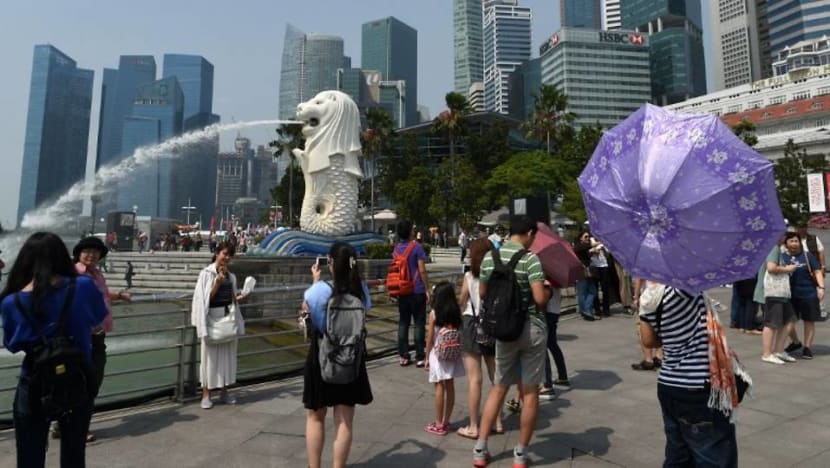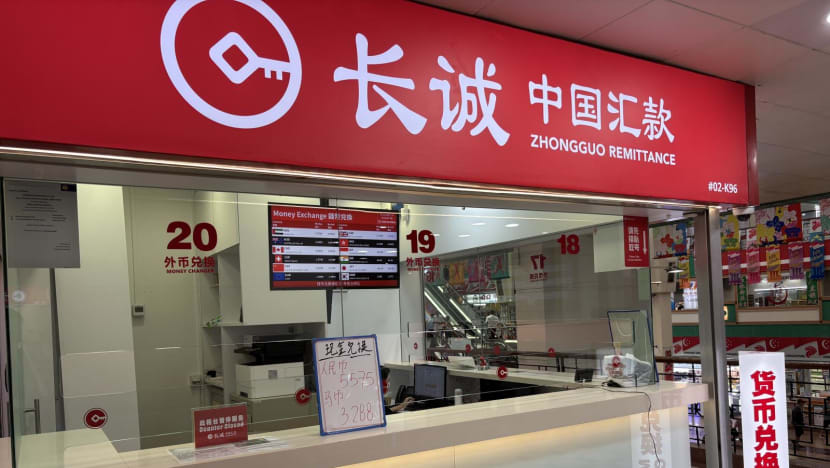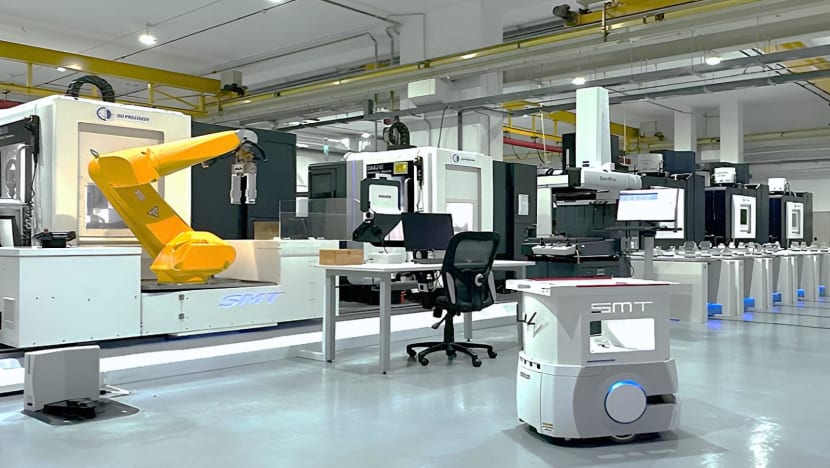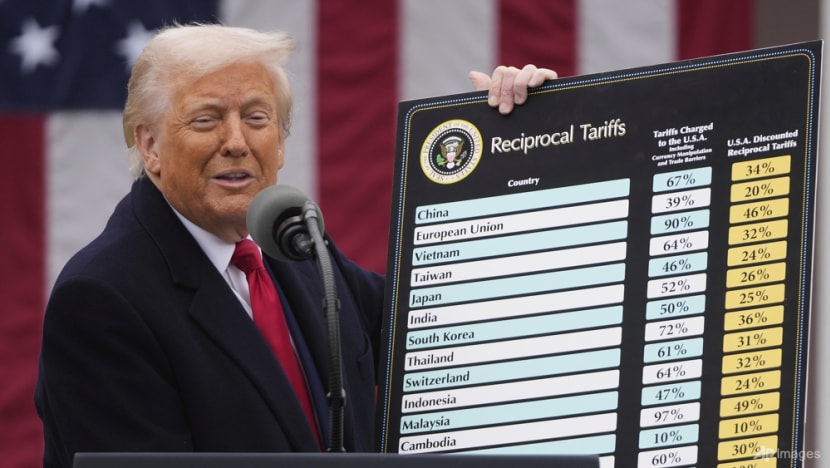Trade wins and holiday woes: Mixed emotions amid the Singdollar’s climb against China’s yuan
CNA speaks with Singaporeans and Chinese nationals about how the exchange rate has affected their spending patterns.

Chinese tourists taking pictures against the iconic Merlion statue in Singapore. (File photo: AFP/Roslan Rahman)

This audio is generated by an AI tool.
SINGAPORE: Like many cost-conscious Chinese nationals abroad, Kevin Wang, a 23-year-old master's student from Qingdao studying in Singapore, has been fervently monitoring foreign currency rates.
Two particularly important currencies have been the Chinese yuan and the Singapore dollar (SGD), Wang said, because being on exchange in a country as expensive as Singapore can be costly.
“It influences my spending choices while I’m here,” Wang said, adding that food, transport and accommodation in Singapore were “very expensive” compared to lower prices back in China.
Spending has become tougher for Wang in recent months, as the SGD climbed against the yuan and hit a 28-year high on Jul 2 at 1:5.631 - according to statistics by the Monetary Authority of Singapore (MAS).
In early May and in early July, the SGD traded at around 5.63 against the yuan, marking a 22 per cent increase from around 4.61 in February 2022.
According to Monetary Authority of Singapore (MAS) data, the SGD:RMB rate was 1:5.631 on Jul 2, which appears to be a 28-year high. The last time it was higher was on Aug 1, 1997, at 5.643.
“When I first arrived, things were already expensive,” said Wang, who came to Singapore in 2024.
He is now more cautious about spending.
"If it's a non-essential item, I won't buy it unless I truly want it," he said.
The Singapore dollar, often ranked as one of Asia’s best-performing currencies, has continued to grow in strength over the past year, analysts said, trading at record highs against global counterparts like the Japanese yen and US dollar.
“The Singapore dollar has held firm and maintained its strength against other currencies in the region, also gaining on the weakening US dollar,” said Jeff Ng, director and Head of Asia Macro Strategy at Sumitomo Mitsui Banking Corporation.
In contrast, the Chinese yuan “saw more stability” despite appreciating in value against the US dollar, Ng said.
“What we have noticed is the Singdollar strengthening against a weakening US dollar, with the yuan remaining stable,” Ng said.
“In a way, this reflects that the Singdollar has (continued to) strengthen over the past three months while the yuan has underperformed.”
Strong fundamentals, like Singapore’s safe haven appeal, robust economic growth and easing of monetary policies, have aided the Singdollar’s stability and growth, he added.
Its rise against the yuan began in early April, said Sim Moh Siong, commodities strategist from the Bank of Singapore, adding that it also reflects the weakening of the US dollar due to its trade tariff escalations.
“This weakness has led to the current highs (we are seeing) between the Singapore dollar and Chinese yuan, with the Singdollar appreciating more than the yuan against the greenback,” he told CNA.

BOON OR BANE FOR TOURISTS?
One group set to benefit from a stronger Singdollar: outbound Singaporeans travelling to China, experts said.
A stronger Singdollar would translate into more spending yuan - allowing them to stretch their travel budgets and spend more on accommodation, dining and entertainment options in China.
Chrislyn Ng, a 22-year-old NTU student on a month-long summer exchange programme at Fudan University in Shanghai, has been enjoying the perks of a stronger Singdollar.
Things have always been cheaper in China, Ng said, but the new currency highs have made dining out and visiting popular attractions even more affordable.
“It makes me more willing to spend,” she added.
To commemorate her trip, she spent 380 yuan (S$68) on a portrait photoshoot in Shanghai, which included full costume changes, makeup services as well as post-production editing.
The experience was “definitely value for money”, Ng said.
“If I did a similar shoot in Singapore, I would have paid more, and services might have been more rushed.”

Also benefitting from a strong Singdollar against a weaker yuan are Chinese nationals working in Singapore sending their hard earned money home.
Jiang, a 42-year-old labourer, recently remitted 29,000 yuan to family members back in China. This month, they would be receiving slightly more yuan, Jiang said.
“I remit money on a routine basis, every two to three months or so. It goes without saying that if I'm sending money back home, the higher the rate, the better,” Jiang said.

On the flip side, experts say a weaker yuan “creates more caution” among budget-conscious Chinese tourists and travellers, who already feel that Singapore is too expensive.
“This will likely dampen discretionary spending on luxury shopping, F&B establishments and wellness experiences,” said Subramania Bhatt, founder and CEO of China Trading Desk, a Chinese-focused travel consultancy.
Chinese tourists who spoke to CNA recounted paying higher prices for food, hotel stays and transport fees because of a stronger Singdollar.
Visiting Singapore had been a very expensive holiday for Liao Chao, a Chinese tourist who had travelled from the southern Guangdong province with his wife and children.
The family of six, who have also holidayed in Hong Kong, forked out close to S$3,580 for a five-night stay at a luxury downtown hotel.
Transport also did not come cheap - they spent an average of at least S$200 a day on “bigger and more premium rideshare options” to get around.
“Because of how expensive things are in Singapore to begin with, the higher exchange rates have made us try to avoid spending money on non-essentials," Liao said.
“So after our time here, I can definitely say that Singapore is more expensive than Hong Kong,” he added.

Ella Zhang, 31, and Nancy Chen, 29, who had travelled to Singapore from the city of Hangzhou to visit friends and sightsee, were careful about their travel expenses and spending.
“We didn’t buy much,” Zhang told CNA, estimating that she spent around S$50 on cosmetics and perfume. They also relied on cheaper off-peak rideshare services to get around.
“It’s definitely way more expensive than what we would pay for similar services back home,” Zhang said.
Spending hard-earned yuan in Singapore was not ideal, Chen said.
“It’s too expensive to get by in Singapore. I don’t think we would come back (unless) we visit friends or for work.”
IMPACT ON BUSINESSES
The yuan’s weakening against the Singapore dollar would most likely be a bane for Chinese businesses that import high-value products manufactured and distributed from Singapore, experts said, adding that prices were also likely to increase.
But at the same time, the Singdollar’s rise would allow Singaporean companies to invest in China at lower costs and rates.
Soo Wei Chieh, executive director of the Singapore Business Federation’s (SBF) international business division, said that a stronger Singdollar would enable Singapore companies to expand or deepen their market presence in China.
There has also been a growing interest in Singapore-based companies and consultancies looking to partner with Chinese counterparts, Soo added.
“With setup costs and investment outlays in China now offering more value, there has been a noticeable uptick in business interest and activity,” he said.
Local entrepreneur Marcus Sia is the founder of Applied Total Control Treatment (ATC), a leading precision engineering company headquartered in Singapore, which also runs manufacturing facilities and operations in Malaysia.
A stronger Singapore dollar means that Sia’s clients in China would have to pay more, potentially resulting in more competition from rival Chinese manufacturers.
But Sia isn’t worried.
“Our competitors are not able to produce products of similar high quality that are required in high-stakes industries like aerospace and semiconductor applications,” Sia said.
“Our Chinese clients would not consider ordering from (them) because of concerns over stringent quality requirements,” he said, adding that he was confident demand would remain stable.

PREDICTIONS AHEAD
Analysts are confident that current exchange highs between the Singapore dollar and the yuan will remain the same for much of 2025.
As of Aug 7, the Singdollar eased gradually to around 5.593 against the yuan, according to MAS figures.
Ng predicts that it will continue to “hover between 5.5 and 5.6” without any major changes.
“It’s more likely both currencies will remain at similar levels and hover around 5.6 for the time being,” Ng said.
The Singapore dollar may also likely make some gains against currencies around the region, while losing to others, Ng said.
“It may not be able to maintain the same level of outperformance and may weaken against currencies like the South Korean won or the Malaysian ringgit, which are projected to appreciate more against the US dollar.”
But at the end of the day, the performance of these currencies against the Singapore dollar is ultimately dependent on how all of them fare against the US dollar.
Sim expects the yuan to continue its upward trend of gradual strengthening. However, this would mean that there would most likely be no aggressive moves to tighten the yuan to increase its value.
He agrees that exchange rates are “set to hover around 5.6”.
Economic uncertainty is also expected in the second half of the year, and things could worsen depending on tariff outcomes.

If tariffs are imposed on US trading partners worldwide, observers say businesses might be more apprehensive to invest or have as many dealings, for fear of potential losses, or being unable to maintain their bottom lines.
China’s heavily export-dependent economy would then have to bear the brunt under increasing tariffs and potential trade war pressures as a result.
And if demand for Chinese exports does fall, so will demand for the yuan, causing it to further devalue against the greenback, and ultimately the Singapore dollar.
“We would have to wait and see how the tariffs are really implemented, who they will apply to and when, and what exemptions could be potentially included in policies,” Ng said, adding that it would also depend heavily on US President Donald Trump.
“Will he execute orders or back down and delay things for further renegotiations?”

















